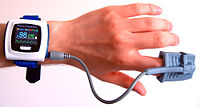
Photo from wikipedia
BACKGROUND primary care screening for frailty status is recommended in clinical guidelines, but is impeded by doctor and nurse workloads and the lack of valid, easy-to-use and time-saving screening tools.… Click to show full abstract
BACKGROUND primary care screening for frailty status is recommended in clinical guidelines, but is impeded by doctor and nurse workloads and the lack of valid, easy-to-use and time-saving screening tools. AIM to develop and validate a new electronic tool (the electronic screening index of frailty, e-SIF) using routinely available electronic health data to automatically and massively identify frailty status in the population aged ≥65 years. METHODS the e-SIF was developed in three steps: selection of clinical conditions; establishment of ICD-10 codes, criteria and algorithms for their definition; and electronic tool design and data extraction, transformation and load processes. The validation phase included an observational cohort study with retrospective data collection from computerised primary care medical records. The study population included inhabitants aged ≥65 years corresponding to three primary care centres (n = 9,315). Evaluated was the relationship between baseline e-SIF categories and mortality, institutionalisation, hospitalisation and health resource consumption after 2 years. RESULTS according to the e-SIF, which includes 42 clinical conditions, frailty prevalence increases with age and is slightly greater in women. The 2-year adjusted hazard ratios for pre-frail, frail and very frail subjects, respectively, were as follows: 2.23 (95% CI: 1.74-2.85), 3.34 (2.44-4.56) and 6.49 (4.30-9.78) for mortality; 2.80 (2.39-3.27), 5.53 (4.59-6.65) and 9.14 (7.06-11.8) for hospitalisation; and 1.02 (0.70-1.49), 1.93 (1.21-3.08) and 2.69 (1.34-5.40) for institutionalisation. CONCLUSIONS the e-SIF shows good agreement with mortality, institutionalisation, hospitalisation and health resource consumption, indicating satisfactory validity. More studies in larger populations are needed to corroborate our findings.
Journal Title: Age and ageing
Year Published: 2022
Link to full text (if available)
Share on Social Media: Sign Up to like & get
recommendations!